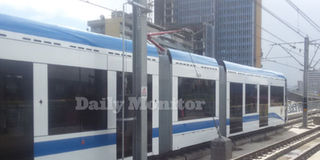Exploring sub-Saharan Africa’s first electric train

A moving train through the city of Addis Ababa. PHOTO BY Emmanuel Ainebyona
What you need to know:
Sub-Saharan Africa’s first light rail system or metro was launched in Addis Ababa last year. The Addis Metro runs 32km from industrial areas south of Addis Ababa to the centre. The tramcars rely on power supplied by overhead wires
About two weeks ago, while attending a two-day immunisation conference at the African Union headquarters in Addis Ababa, Ethiopia, I got an opportunity to explore sub-Saharan Africa’s first light rail system.
The burning desire to use an electronic train was ignited by a social media picture which compared a new train coach used in Addis Ababa and the one used in Kampala.
The pictures were circulated on Facebook and Twitter shortly after Kampala Capital City Authority (KCCA) and Rift Valley Railways launched an experimental commuter train services in Kampala on December 7.
However, to many Ugandans, the pictures were seen as a mockery to the KCCA train services, which in spite of technological advancements, still operates an old metric gauge railway line built during the colonial era as an alternative means to de-congest the city prone to ever increasing traffic jams.
The experience
The journey to the train boarding point began at one of the gates of the African Union (AU) headquarters’ compound.
Girma, a cab driver picked me and dropped me in Mexico, a suburb of Addis Ababa where the light rail crosses.
On our way to the train stop, Girma using his little spoken English, told me that he has not had a chance to use the train services due to his busy schedule as a cab driver.
He also told me that people in Ethiopia largely speak Amharic as well as English as, adding that Ethiopians and Eritreans are the same people.
“I am from Eritrea but after the two countries were split, I found myself in Ethiopia. But we are one and share cultures,” Girma said.
“Here it is expensive to buy cars because of high taxes,” he said. This was after I inquired why there were a lot of old-fashioned car models on Addis Ababa roads. As we approached the train stop in Mexico, Girma inquired if I knew what Addis Ababa meant?
I was frank with him and replied, “no”, without guessing. He then told me that Addis means ‘new’ in Amharic whereas Ababa means ‘flower’. This was clearly envisaged in the well-constructed roads, beautiful people, the scenery and other beautifications that bring out the two words to make it a ‘New Flower’.
At the bus stop
At the Mexico train stop, we parked by the road side and went to the train-ticket office where I got a ticket for my first ride on an electric train. After payment, Girma escorted me to the staircase which led to the train stop. The stop is on an elevated level above the roads.
Addis roads are very wide, well-paved and well lit unlike Kampala roads which are very narrow, poorly paved and not well lit.
My ticket cost Six Birr (about Shs1,000) and within less than five minutes, a blue and white electric coach arrived. Some passengers disembarked, creating space for some of us who were waiting to board.
Surprisingly, no one asked to see my boarding ticket. The journey from the Mexico stop ended at the Stadium-stop where I disembarked to make a return trip.
Inside the coach, all seats were occupied so I took to the aisles just like hundreds of others. I made an acquaintance with one of the passengers who I asked to take my photo.
On top of being comfortable, the electric train is so fast that I did not realise how much time it took me to my final destination. Girma said it is usually less than 15 minutes. The trains are able to reach maximum speed of 70 km/h. The comfort was almost similar to that of a smooth flight free of turbulence.
At every stop, coaches from different directions pick waiting passengers. The first phase of the light rail stretches from Torhailoch up to Ayat and has about 20 boarding stops in-between.
According to Girma, train services in the city have significantly reduced traffic jams on the roads since the train takes bigger numbers of passengers compared to bus transport system.
With more than four million people, Addis Ababa has not been any different from Kampala, where the traditional way of getting around the city is moving in mini vans.
Cost of building light rail infrastructure
Ethiopians started using the Metrorail for commuter services in September last year.
The 32km light-rail infrastructure project was built for about three years by a Chinese company after the Ethiopian government secured 85 per cent of funding from the Export-Import Bank of China.
The $475 million Light Rail Project is a joint venture between Ethiopia and China and the first of its kind for the country as well as sub-Saharan Africa.
According to Ethiopian Railways Corporation, about 60,000 passengers can hop aboard two lines that connect the east and west and north and south of Addis.
The trains run between 6am and midnight.
The initial stage of the operation is being overseen by the Chinese company Shenzen, as an exchange of skills and culture between Chinese and Ethiopian workers.
Once completed, the light rail will connect with the national train system of Ethiopia, and by 2025, there will be 5,000km of track across the whole of the country.
The long-term goal is not just to connect Ethiopia, but to see the country connected to Djibouti, Sudan and Gabon.
Uganda government’s plans
Meanwhile, the Uganda government last year signed a memorandum of understanding with the Chinese government for the construction of a light rail network in Kampala.
It will be built by China Civil Engineering Construction Corp, the first phase is expected to cost US$440m (Shs1.4trillion) to build and would extend for 35km on an elevated alignment as four routes are expected to be operational by 2020.
It is also expected to be in conjoined with the 1,435 mm gauge rail network on which work is due to start this year.
The network could eventually total 240 km, connecting the capital with the surrounding towns of Entebbe, Nsangi and Wakiso.
In Africa, South Africa championed a rail train system followed by Addis Ababa and a much-delayed light-rail system in Lagos, Nigeria, which is still under construction.
In Kampala, RVR has provided five refurbished coaches for the service.
The company runs four trips a day between Kampala and Namanve, around 14km east of the capital on the main line towards the Kenyan border at Busia. As well as serving the Namanve Industrial Park, the route also passes close to the city’s Mandela National Stadium and Kyambogo University.
According to the schedules, the morning train leaves Namanve at 06.30am, returning from Kampala at 07.35am.
The afternoon train departs from Namanve at 4.15 and arrives at the Kampala stop at 5.30. Journey time is around 40 minutes, with a flat fare of Shs1,500.
However, Kampala residents have not fully embraced the train system, instead taking commuter taxis and boda bodas.
This means traffic jams remain a challenge for the city authorities who are now thinking of introducing cable cars, flyovers, Rapid Bus transport and non-motorised means such as the use of bicycles. But, the blueprints all remain largely on paper.
Meanwhile, the Uganda government last year signed a memorandum of understanding with the Chinese government for the construction of a light rail network in Kampala.
It will be built by China Civil Engineering Construction Corp, the first phase is expected to cost US$440m (Shs1.4trillion) to build and would extend for 35km on an elevated alignment as four routes are expected to be operational by 2020.
It is also expected to be in conjoined with the 1,435 mm gauge rail network on which work is due to start this year.
The network could eventually total 240 km, connecting the capital with the surrounding towns of Entebbe, Nsangi and Wakiso.
In Africa, South Africa championed a rail train system followed by Addis Ababa and a much-delayed light-rail system in Lagos, Nigeria, which is still under construction.
In Kampala, RVR has provided five refurbished coaches for the service.
The company runs four trips a day between Kampala and Namanve, around 14km east of the capital on the main line towards the Kenyan border at Busia. As well as serving the Namanve Industrial Park, the route also passes close to the city’s Mandela National Stadium and Kyambogo University.
According to the schedules, the morning train leaves Namanve at 06.30am, returning from Kampala at 07.35am.
The afternoon train departs from Namanve at 4.15 and arrives at the Kampala stop at 5.30. Journey time is around 40 minutes, with a flat fare of Shs1,500.
However, Kampala residents have not fully embraced the train system, instead taking commuter taxis and boda bodas.
This means traffic jams remain a challenge for the city authorities who are now thinking of introducing cable cars, flyovers, Rapid Bus transport and non-motorised means such as the use of bicycles. But, the blueprints all remain largely on paper.
project was built for about three years by a Chinese company after the Ethiopian government secured 85 per cent of funding from the Export-Import Bank of China.
The $475 million Light Rail Project is a joint venture between Ethiopia and China and the first of its kind for the country as well as sub-Saharan Africa.
According to Ethiopian Railways Corporation, about 60,000 passengers can hop aboard two lines that connect the east and west and north and south of Addis.
The trains run between 6am and midnight.
The initial stage of the operation is being overseen by the Chinese company Shenzen, as an exchange of skills and culture between Chinese and Ethiopian workers.
Once completed, the light rail will connect with the national train system of Ethiopia, and by 2025, there will be 5,000km of track across the whole of the country.
The long-term goal is not just to connect Ethiopia, but to see the country connected to Djibouti, Sudan and Gabon.




